Chengde is located in the northeast of Hebei Province. Its range is between latitude 40°12′ – 42°37′ north and longitude 115°54′ – 119°15′ east. It is in the connecting and transitional zone between North China and Northeast China. It is close to Beijing and Tianjin. It backs on Inner Mongolia and Liaoning. In the province, it is adjacent to Qinhuangdao and Tangshan, two coastal cities, and Zhangjiakou City. In the north, it is adjacent to Chifeng City and Xilingol League of Inner Mongolia Autonomous Region. The terrain drops in steps from northwest to southeast. The northwest part is located in the Inner Mongolia Plateau – Bashang Plateau area. The altitude is mostly between 1,200 meters and 2,000 meters. Therefore, there are obvious differences in climate between the north and the south. In winter, it is cold and with little snow. In spring, it is dry and with little rain. In summer, it is mild and with many thunderstorms. In autumn, it is cool and has a large temperature difference between day and night. Among them, the Chengde tourist area (such as: Mountain Resort) belongs to a temperate continental monsoon mountain climate.
Bus: There are many passenger buses to Chengde at Beijing Liuliqiao Passenger Transport Center and Sihui Station.
Train:
K7753 Beijing – Chengde Departure time: 00:26 Driving time: 6 hours and 24 minutes
K7711 Beijing – Chengde Departure time: 07:56 Driving time: 4 hours and 35 minutes
4471 Changping North – Chengde Departure time: 10:52 Driving time: 8 hours and 38 minutes
2257 Beijing – via Chengde – Dandong Departure time: 12:20 Driving time: 5 hours
Y513 Handan – Chengde Departure time: 13:04 Driving time: 5 hours and 30 minutes
K1457 Shijiazhuang – via Chengde – Tongliao Departure time: 22:35 Driving time: 4 hours and 39 minutes
High-speed rail:
G3721/G3724 Dalian North Station – Chengde South Station
G3704 Shenyang North Station – Chengde South Station
Airplane:
Xi’an – Chengde
3,About characteristic delicacies
Stewed Meat in Pot is one of the characteristic delicacies of Chengde. With a long history, the meat pieces are dark red in color, original in flavor, fat but not greasy, richly fragrant, and extremely tender. It is a traditional flavorful dish deeply loved by the people of Chengde.
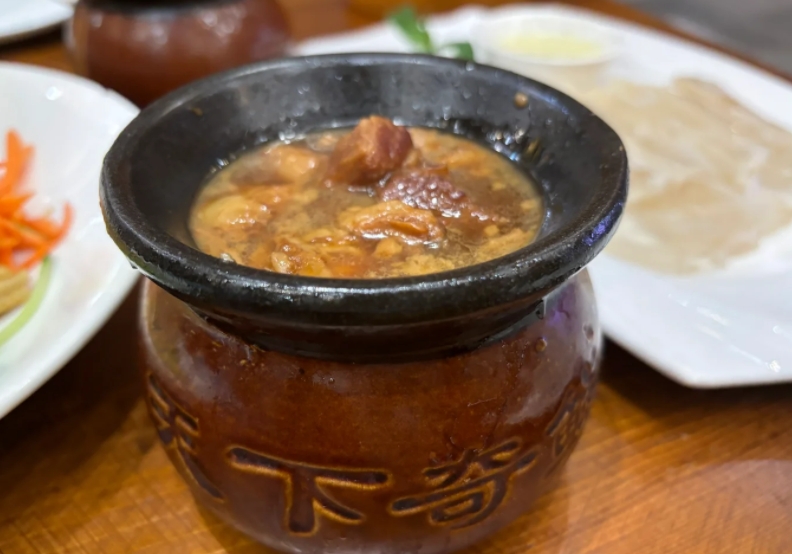
Stewed Meat in Pot
Pan-fried Wotou: The raw materials are buckwheat flour, mung bean flour, five-spice powder, Sichuan pepper powder, etc. Its characteristics are rich in nutrition, sour, spicy, fragrant, smooth and chewy. It is an economical and popular food. It has a unique flavor and increases your appetite.
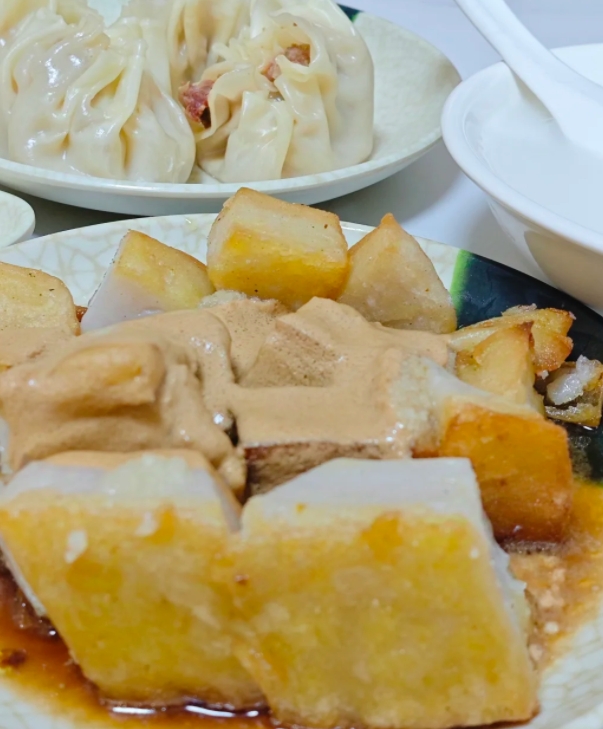
Fried bowl lump
Imperial Lotus Leaf Chicken originated from “beggar’s chicken”. The cooking method is similar to that of beggar’s chicken. Lotus Leaf Chicken is delicious. Especially that faint, almost imperceptible fragrance of lotus leaf makes your appetite open and the aftertaste is long.
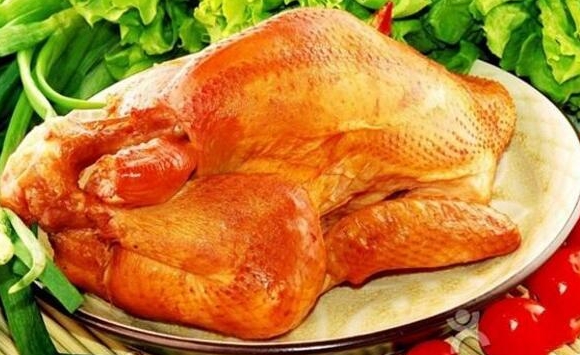
Imperial Lotus Leaf Chicken
Chengde Jelly Noodles is a characteristic traditional snack in Chengde area, Hebei Province. After shaping, use a blade to leak the noodles into shreds and put them in a bowl. Add various seasonings according to personal taste and mix well. It is smooth, refreshing, and cool, relieving the summer heat.
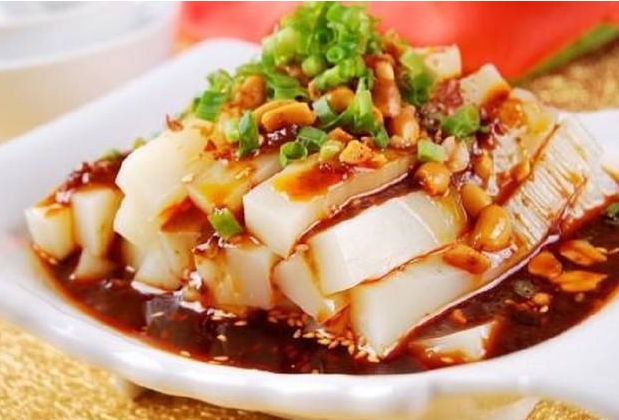
Chengde Jelly Noodles
Chengde Lvdagun (Glutinous Rice Rolls Stuffed with Red Bean Paste). The making method has a long history. When making it, it is required that the filling be rolled evenly with distinct layers. The appearance is yellow. The characteristics are fragrant, sweet, sticky, and with a strong fragrance of soybean flour.
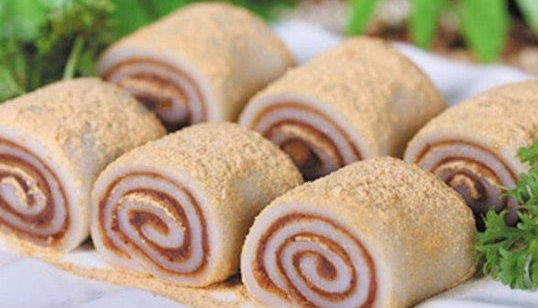
Chengde Lvdagun (Glutinous Rice Rolls Stuffed with Red Bean Paste)
Dushui Tofu is shaped like tofu pudding. It is white in color, glittering and translucent, and nearly transparent. When eating, it is served in a small shallow container woven from willow branches after peeling, which is approximately in the shape of a boat. The small shallow container is placed on a basin to remove the slurry. It is pleasing to the eye when looking at it; it has a mellow fragrance when smelling it; it is smooth and delicate when entering the mouth.
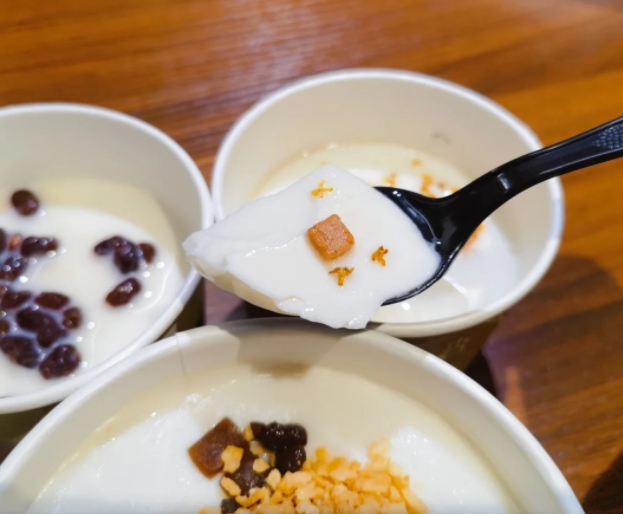
Dushui Tofu
Roses are not only famous flowers outside the Great Wall but also designated as the city flower of Chengde City, Hebei Province. Making pastries with roses has a history of nearly 300 years in Chengde. Beautiful in shape, bright in color, soft and crispy, with an attractive rose fragrance, it is an excellent gift for relatives and friends.
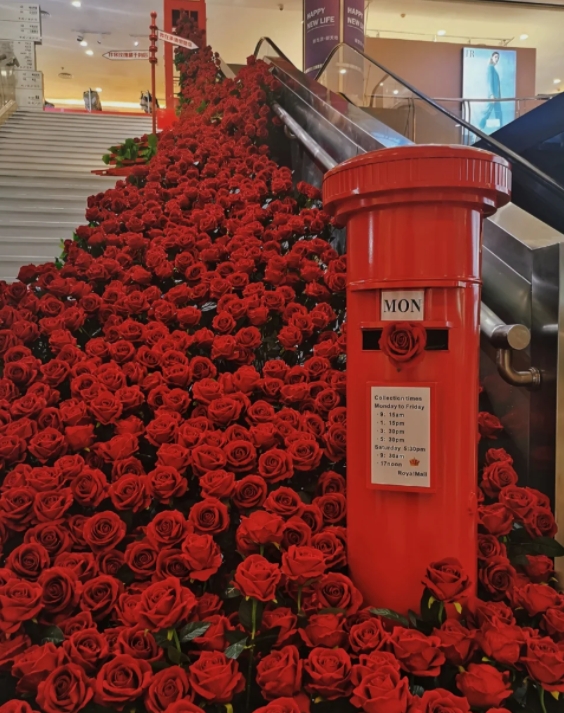
Roses
Driving: The Mountain Resort is close to the urban area. The biggest problem that may be encountered when driving during the peak season is parking. Now, the parking lots around the Mountain Resort are roughly: Dehuimen Parking Lot, Lizhengmen Parking Lot, Underground Parking Lot of Chengde Mountain Resort, Parking Lot on Shanzhuang East Road, Parking Lot of Chengde Mountain Resort (Shanzhuang Road), Parking Lot of Jinlong Shopping Plaza, Parking Lot of Chengde Grand Theatre.
Public transportation: Get off at the Mountain Resort Station by taking Bus No. 5, No. 6, No. 6 (interval), No. 10, No. 11, or No. 15.
The starting price of taxis is 7 yuan. The fares of taxis inside railway stations and bus stations are a bit higher than those outside. It is recommended to hail a taxi on the roadside.
- Mountain Resort
For Chengde, the Mountain Resort is a business card for the outside world. I believe that most people get to know Chengde starting from the Mountain Resort.
The Mountain Resort was built in 1703. It took 89 years to complete through the reigns of Emperor Kangxi, Emperor Yongzheng, and Emperor Qianlong of the Qing Dynasty. The Mountain Resort is in a style of simple and elegant rural charm. It takes the natural colors of mountains and waters and absorbs the scenery of both the south of the Yangtze River and the north of the Great Wall. It has become the largest existing ancient imperial palace garden in China.
The Mountain Resort is divided into four major parts: palace area, lake area, plain area, and mountain area. The entire resort has more water in the southeast and more mountains in the northwest. It is a microcosm of China’s natural landforms. It is a glorious milestone in the history of Chinese gardens. It is a masterpiece of Chinese classical garden art and the highest example of Chinese classical gardens.
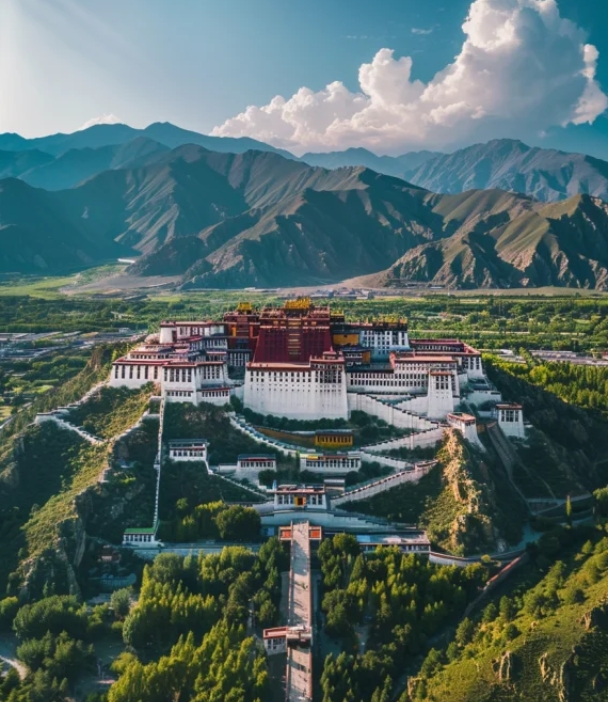
Mountain Resort
The palace area is located in the southern part of the Mountain Resort. It is connected to the plain area and lake area in the northeast and the mountain area in the northwest. The main building is in the middle, and the ancillary buildings are placed on both sides, basically balanced and symmetrical. It makes full use of the natural environment and is modified to skillfully combine natural landscapes and human landscapes, making the palace buildings in the Mountain Resort garden-like while also showing the grandeur of a royal garden. The palace area is composed of four groups of buildings: the main palace (opened as the Mountain Resort Museum), Songhe Zhai, the East Palace (destroyed), and Wanhe Songfeng.
The Mountain Resort is one of the three major ancient architectural complexes in China. Its greatest characteristic is that there are gardens in the mountains and mountains in the gardens. There are more than 120 groups of large and small buildings. Among them, Emperor Kangxi composed 36 scenes with four characters, and Emperor Qianlong composed 36 scenes with three characters. These are the famous 72 scenes of the mountain resort.
The 36 scenes named in the Kangxi period are:
Cool Breeze from the Misty Waves, Path on the Cloudy Bank, Coolness without Heat, Mountain Villa for Delaying Summer Heat, Beautiful Rocks with Flowing Water, Myriad Ravines and Pines in the Breeze, Clear Shade of Pines and Cranes, Splendid Mountain Land, Clouds Surrounding on All Sides, Twin Peaks as Pillow in the North, Morning Glow over the Western Range, Setting Sun over the Hammer Peak, Snow on the Southern Mountains, Pear Blossoms Accompanied by the Moon, Fragrance of Curved Water and Lotus, Listening to the Wind and Spring, Longing for the Brook and Pond, Harmony between Heaven and Earth, Warm Currents and Rippling Waves, Spring Source on the Stone Wall, Green Islet with Green Maples, Orioles Singing among Tall Trees, Fragrance Spreading Far and Becoming More Delicate, Golden Lotus Reflecting the Sun, Sounds of Springs Near and Far, Boat with Cloudy Sails and Moon-shaped Hull, Shoal Facing the Flowing Water, Appearance of Clouds and Water, Clear Spring Winding around Rocks, Clear Waves and Layers of Greenery, Watching Fish on the Rocky Jetty, Mirror-like Water and Cloudy Peaks, Twin Lakes with Mirrors in Between, Rainbow Drinking the Flow, Luxuriant Groves in the Open Country, Water Flowing and Clouds Drifting.
The 36 scenes named in the Qianlong period are:
Lizhengmen Gate, Diligent Government Hall, Songhe Zhai, Ruyi Lake, Green Bird Boat, Beautiful View Tower, Deer Slope, Water Heart Pavilion, Yizhi Hall, Changyuan Terrace, Jinghao Hall, Cold Fragrance Pavilion, Picking Water Chestnuts Ferry, Lotus Viewing Place, Qinghui Pavilion, Prajna Aspect, Canglang Isle, A Patch of Cloud, Fragrant Water Pond, Ten Thousand Trees Garden, Horse Testing Ground, Fine Tree Pavilion, Tower of Happiness and Success, Eaves of Sleeping Clouds, Chengguan Studio, Green Cloudy Rock, Painted Window, Ascending the Void, Thousand Feet of Snow, Tranquil Studio, Jade Zither Pavilion, Near the Fragrant Villa, Rock of Knowing Fish, Surging Green Rock, Plain and Elegant Studio, Eternal Peace Residence.
- Putuo Zongcheng Temple (also known as Little Potala Palace)
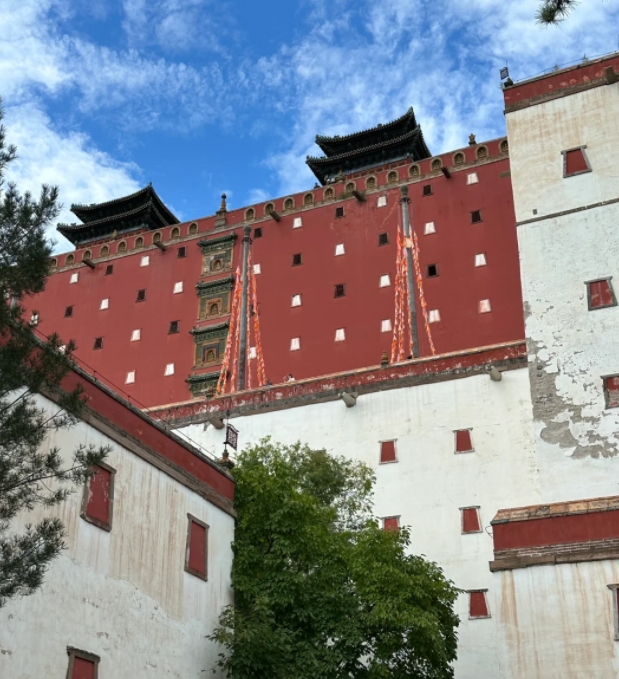
Putuo Zongcheng Temple
Putuo Zongcheng Temple was built in 1767 (the thirty-second year of the Qianlong period) and completed four years later. It is the largest temple among the “Eight Outer Temples”. Built by imitating the Potala Palace in Lhasa, it is commonly known as Little Potala Palace. There are about 60 large and small buildings in this temple. Halls and towers are scattered everywhere. Facing the water and relying on the mountains, it cleverly makes use of the terrain and scenery for setting off. The layout is flexible without losing its solemnity. The main building, the Grand Red Terrace, is 43 meters high. The Hall of the Reunion of All Dharmas in the center of the terrace is the main hall. The top of the hall is higher than the surrounding buildings. The roof of the hall is covered with gilded copper tiles with fish scales, shining golden and extremely magnificent. At the bottom, because of the enclosure of three-story buildings, the shadow is dark and the light contrast is distinct, creating a solemn religious atmosphere. It is a treasure in religious architecture. In recent years, the ethnic and religious song and dance “The Light of Putuo” has been grandly launched on the “Imperial Seat Tower” on the Grand Red Terrace. By refining major events such as the completion of the temple, the emperor’s birthday celebration, and the return of the Torghut tribe, it uses song and dance forms to show the strong centripetal force and cohesion of the Chinese nation during the “Prosperous Age of Kangxi and Qianlong” and the common aspiration of people of all ethnic groups across the country to create a prosperous and peaceful era and a prosperous China. At present, every morning, tourists can watch “The Light of Putuo” on the “Imperial Seat Tower” where emperors in the past enjoyed song and dance.
- Puning Temple
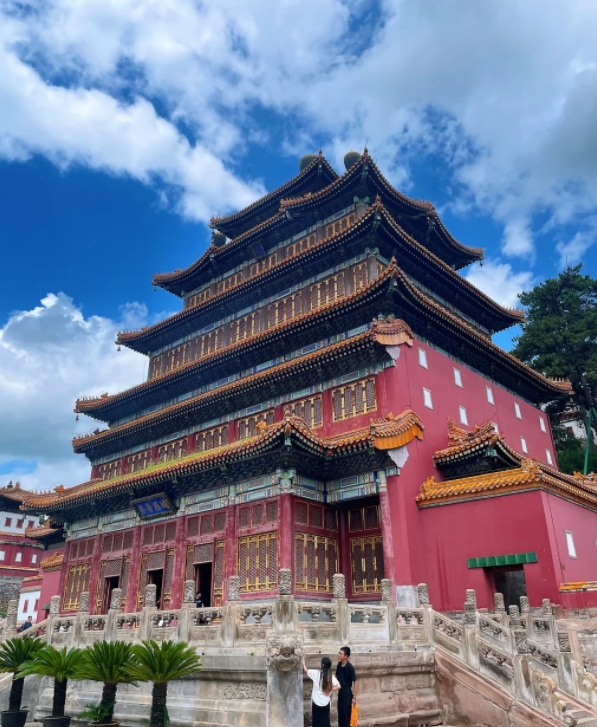
Puning Temple
Puning Temple was built in 1775. In 1961, it was approved as a national key cultural relic protection unit. In 1985, it was approved as a religious activity site by the State Administration for Religious Affairs. In 1994, it was approved as a world cultural heritage by UNESCO. The temple covers an area of 33,000 square meters and has 29 buildings of various types including halls and towers. With the pattern of integrating the emperor and the Buddha, it has both the grand scale of a magnificent royal temple and is also the center of the “Mandala Buddhist Kingdom”, a holy place for Buddhism.
The main building, the Mahavira Hall, is a double-eaved hip-roofed style, known as the “Nine Ridges and Ten Dragons” hall. Inside, there are statues of the Buddhas of the Three Ages and eighteen arhats, surrounded by murals. The two main buildings in the front and back are both built on a 1.4-meter-high stone-built Sumeru pedestal. The platform in front of the hall is surrounded by exquisitely carved stone railings. In the center of the steps, there is a stone carving art masterpiece “Cloud Dragon Stone Steps”. At the four corners are dragon heads called “chi”. The “Golden Dragon and Seal Script” and “Six-Character Mantra and Seal Script” colored paintings in the temple are even more unique among ancient architectural paintings.
- Qingchui Peak Scenic Area
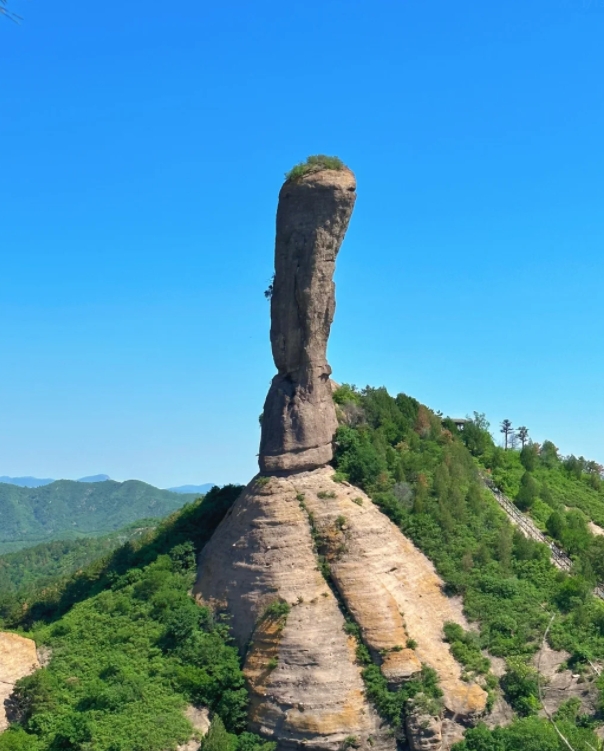
Qingchui Peak Scenic Area